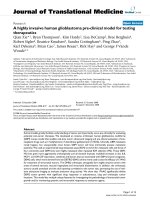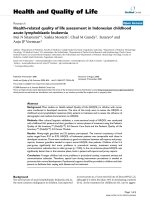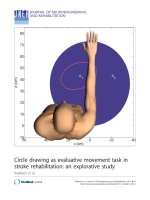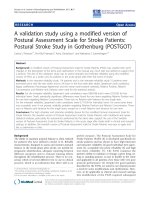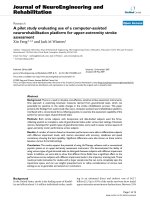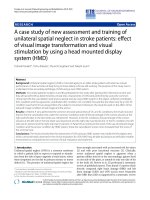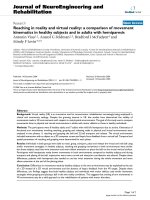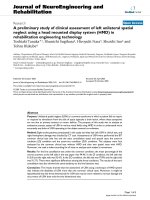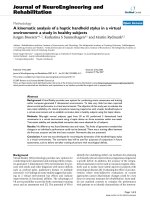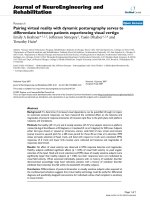báo cáo hóa học: " A virtual reality extended neuropsychological assessment for topographical disorientation: a feasibility study" pot
Bạn đang xem bản rút gọn của tài liệu. Xem và tải ngay bản đầy đủ của tài liệu tại đây (763.37 KB, 5 trang )
BioMed Central
Page 1 of 5
(page number not for citation purposes)
Journal of NeuroEngineering and
Rehabilitation
Open Access
Research
A virtual reality extended neuropsychological assessment for
topographical disorientation: a feasibility study
Francesca Morganti*
1,2
, Andrea Gaggioli
1
, Lorenzo Strambi
1
,
Maria Luisa Rusconi
3
and Giuseppe Riva
1
Address:
1
Applied Technology for Neuro-Psychology Lab, Istituto Auxologico Italiano, Via G. Pelizza da Volpedo 41, I-20149 Milano, Italy,
2
Institute of Psychology and Sociology of Communication, University of Lugano, Via G. Buffi 13, CH 6904 Lugano, Switzerland and
3
Department
of Human Science, University of Bergamo, Piazzale S. Agostino 2, I-24129 Bergamo, Italy
Email: Francesca Morganti* - ; Andrea Gaggioli - ;
Lorenzo Strambi - ; Maria Luisa Rusconi - ; Giuseppe Riva -
* Corresponding author
Abstract
Background: Topographical disorientation represents one of the main consequences of brain
injury. Up to now several methodological approaches have been used in the assessment of the brain
injured patient's navigational abilities showing a moderate correlation with the impairments
observed in everyday contexts.
Methods: We propose a combination of standardized neuropsychological tests and a more
situated virtual reality-based assessment for the evaluation of spatial orientation in brain injured
patients.
Results: When tested with this virtual reality integrated procedure patients showed performance
and execution times congruent with their neuropsychological evaluation. When compared to a
control group, patients revealed significantly slower times and greater errors in solving virtual
reality based spatial tasks.
Conclusion: The use of virtual reality, when combined with classical neuropsychological tests, can
provide an effective tool for the study of topographical disorientation.
Background
Topographical disorientation, when associated with a
complex cognitive impairment, represents one of the
main consequences of extended brain injury and occurs
most frequently from damage in the parietal/temporal/
occipital regions [1-5].
Patients with topographical disorientation revealed
impairment in the capacity to orient oneself in and to
cope with everyday environments. Despite this statement,
up to now most of the evaluation tools for topographical
disorientation introduced laboratory methodologies in
order to understand how people explore three-dimen-
sional spaces [6-12].
Laboratory evaluation does not support an immediate
and direct interaction generally possible in the daily envi-
ronment, and constitutes an important bias for the evalu-
ation of spatial impairments in brain damage, often
making clinicians desire a more ecological approach. Eco-
Published: 11 July 2007
Journal of NeuroEngineering and Rehabilitation 2007, 4:26 doi:10.1186/1743-0003-4-26
Received: 26 January 2007
Accepted: 11 July 2007
This article is available from: />© 2007 Morganti et al; licensee BioMed Central Ltd.
This is an Open Access article distributed under the terms of the Creative Commons Attribution License ( />),
which permits unrestricted use, distribution, and reproduction in any medium, provided the original work is properly cited.
Journal of NeuroEngineering and Rehabilitation 2007, 4:26 />Page 2 of 5
(page number not for citation purposes)
logical methods, in fact, might help clinicians to observe
the strategy used by a patient to explore a natural environ-
ment, and to understand the characteristics of the envi-
ronment utilized to help in familiarization. On the other
hand, the observation of a patient in daily contexts gener-
ates many questions about the reliability and interpreta-
tion of collected data. In order to avoid biases the design
of an effective assessment tool that links a reliable evalua-
tion methodology with a more situated observation of
spatial behaviors appears to be still needed.
A promising way could be to integrate classical evaluation
tools with computer-based interactive ones, such as vir-
tual reality, in order to evaluate the navigational capacity
of complex environments by neurological patients by
observing the types of spatial representations that a
patient is able to produce in order to adaptively interact
with space within a given activity.
Virtual reality (VR) environments, in fact, constitute an
interesting opportunity for the evaluation of topographi-
cal disorientation, providing a representation of a
dynamic nature and interactive environments [13,14]. In
particular, we propose that from patients' active interac-
tion with virtual reality simulations it is possible to clearly
understand how the ability to organize spatial knowledge
into a cognitive map is preserved.
The study of spatial cognition has provided evidence of
how it can be represented in a cognitive map which can be
of the "route" or "survey" type [15-18]. The "route" map
is made up of representations of an egocentric nature.
"Survey" maps, on the other hand, are representations of
a higher level, organized according to an allocentric per-
spective. Studies in clinical neuropsychology showed how
the processing of topographical information may be con-
ducted within an egocentric or allocentric coordinate
frame that are mainly comparable to route and survey
knowledge organization [19,20].
According to a particularly theoretical orientation, the
capability of learning spatial relationships in a large scale
environment, and of organizing them into "route" or
"survey" types, is influenced not so much by a major
familiarity with the environment, but by a series of char-
acteristics of the specific environment, capable of assum-
ing a functional role with the activities an agent performs
or is going to perform inside it [21-23]. We propose an
integrated evaluation method in which neuropsychologi-
cal spatial ability evaluation will be extended with more
situated computer based tools that allow the assessment
of spatial orientation during the interaction with complex
3D environments.
Methods
Materials
In order to evaluate patients' spatial abilities with "paper
and pencil" tests a neuropsychological assessment was
performed. For general cognitive level identification Pro-
gressive Raven's Matrixes (PM47) were employed. Token
test, Boston Naming test and phonemic and semantic Flu-
encies were used for verbal abilities evaluation. Memory
ability was assessed through Digit and Corsi's span where
attention and executive functions were evaluated through
the Trial Making test, Attentive matrixes and the Tower of
London test. Finally, spatial ability evaluation required
the Rey's complex figure, Poppelreuter's test, Benton's line
orientation test, Street's Completion test and the Elit-
horn's Perceptual Maze test.
We extended this evaluation by addition of the VR-Maze
test and VR-Road Map. We developed these tools [24] to
support the assessment of spatial orientation during the
interaction with daily complex environments.
The VR-Maze test, depicted in figure 1, is based on the
Wisc-R Maze subtest [25]. Patients were requested to
firstly perform the allocentric paper and pencil version of
eight mazes, to memorize it and after to find the right way
into the equivalent egocentric VR version of the maze. Per-
formance times are recorded for each of the eight mazes.
The VR-Road Map test, depicted in figure 2, is a virtual
reality version of the Road Map Test [26], in which the
paper and pencil version is turned into a simulated and
actively explorable city. No landmark objects were pro-
vided as navigation aids and all the buildings have the
same texture. Patients are requested to follow the desig-
nated route into the virtual environment using the survey
paper and pencil version of the test as a guide map. Per-
formance time and errors were recorded.
The VR Maze testFigure 1
The VR Maze test.
Journal of NeuroEngineering and Rehabilitation 2007, 4:26 />Page 3 of 5
(page number not for citation purposes)
For both the VR systems the possibility to track user's spa-
tial behaviour is provided. Snapshots of the tracking tool
is provided in figure 3 and 4.
Participants
Four male patients with brain damage (mean age = 31.7
years, sd = 1.5 and mean years of school attendance = 16.7
years, sd = 2.5) were tested using paper and pencil neu-
ropsychological evaluation and with the VR-integrated
procedure. Patients' performance on VR-Maze test and
VR-Road Map test were compared to a control group (10
male participants, with a mean age of 29.3 years, sd = 4.5
and 15.5 years of school attendance, sd = 2.6).
Results
All the patients appeared to have deficiencies in spatial
knowledge organization based on their neuropsychologi-
cal assessment. They were all at the same level of deficits
in the organization of spatial knowledge. With regard to
the VR Maze test, in the comparison to the control group,
patients revealed significantly slower execution times in
solving tasks (T-Test = .677; p = .013) and were able to
solve four out of the eight mazes as depicted in figure 5
and 6.
The VR Road Map testFigure 2
The VR Road Map test.
The VR Road Map test tracking toolFigure 4
The VR Road Map test tracking tool.
The VR Maze Test tracking toolFigure 3
The VR Maze Test tracking tool.
VR Maze execution timesFigure 5
VR Maze execution times.
Journal of NeuroEngineering and Rehabilitation 2007, 4:26 />Page 4 of 5
(page number not for citation purposes)
Figure 7 shows how patients' execution times in the VR-
Road Map tests appeared to be higher than those of the
control group and all patients were unable to reach the
final target point. The control group did not show any dif-
ficulty in doing this.
Discussion and Conclusion
Both in the VR-maze and in VR-Road Map tests, patients'
execution times were higher than those of the control
group. Moreover, patients' performance in the VR-maze
and in the VR-Road Map tests were lower when compared
to the control group.
These results underline how patients' performance and
execution times in VR tests are congruent with their neu-
ropsychological evaluation.
VR environments provide the possibility of an egocentric
interaction that will highlight patient's difficulty in the
translation of survey spatial knowledge into a route one.
It could be considered the main feature of topographical
disorientation disease.
The integration of virtual reality with traditional evalua-
tion methods may provide an interesting alternative to
paper and pencil-based approaches, thereby contributing
to an improvement in the evaluation of topographical dis-
orientation [27].
The observation of patients' performance allows an assess-
ment of their difficulty in the translation of survey knowl-
edge to route knowledge. In accordance with their
impairment, they were able to memorize sequences of
paths when provided in a top-view perspective (the survey
one). This residual ability is usually assessed using classi-
cal neuropsychological evaluation since paper and pencil
materials provide spatial relations mainly from a top-
down view. In contrast, the integrated approach we have
proposed allows an analysis of the survey-route transla-
tion of knowledge. In conclusion, the use of virtual reality
appears to provide an effective and objective tool for the
study of topographical disorientation when combined
with classical neuropsychological tests.
Competing interests
The author(s) declare that they have no competing inter-
ests.
Authors' contributions
FM, AG, LS, MLR and GR equally participated to the
design and execution of the study. All authors read and
approved the final manuscript.
Acknowledgements
This work was supported in part by the Italian MIUR FIRB programme,
Project NEUROTIV – RBNE01W8WH
References
1. De Renzi E: Disorders of space exploration and cognition Chichester:
Wiley; 1982.
2. Paterson A, Zangwill OL: A case of topographical disorientation
associated with a unilateral cerebral lesion. Brain 1945,
68:188-212.
3. Whiteley AM, Warrington EK: Selective impairment of topo-
graphic memory: a single case study. J Neurol Neurosurg Psychi-
atry 1978, 41:575-578.
4. De Renzi E, Faglioni P, Villa P: Topographical amnesia. Journal of
Neurology, Neurosurgery & Psychiatry 1977, 40:498-505.
5. Barrash J: A historical review of topographical disorientation
and its neuroanatomical correlates. Journal of Clinical and Exper-
imental Neuropsychology 1998, 20(6):807-827.
6. Lawton CA: Gender differences in way-finding strategies:
Relationship to ability and spatial anxiety. Sex Roles 1994,
30:765-779.
7. Pazzaglia F, De Beni R: Strategies of processing spatial informa-
tion in survey and landmark-centred individuals. European
Journal of Cognitive Psychology 2001, 13:493-508.
8. Juan-Espinosa M, Abad FJ, Colom R, Truchaud MF: Individual differ-
ences in large-space orientation: g and beyond? Personality and
Individual Differences 2000, 29:85-98.
VR Road Map execution TimesFigure 7
VR Road Map execution Times.
Number of solved VR MazesFigure 6
Number of solved VR Mazes.
Publish with BioMed Central and every
scientist can read your work free of charge
"BioMed Central will be the most significant development for
disseminating the results of biomedical research in our lifetime."
Sir Paul Nurse, Cancer Research UK
Your research papers will be:
available free of charge to the entire biomedical community
peer reviewed and published immediately upon acceptance
cited in PubMed and archived on PubMed Central
yours — you keep the copyright
Submit your manuscript here:
/>BioMedcentral
Journal of NeuroEngineering and Rehabilitation 2007, 4:26 />Page 5 of 5
(page number not for citation purposes)
9. Just MA, Carpenter P: Cognitive coordinate systems: Accounts
of mental rotation and individual differences in spatial abil-
ity. Psychological Review 1985, 92:137-172.
10. Casey MB: Understanding individual differences in spatial abil-
ity within females: A nature/nurture interactionist frame-
work. Developmental Review 1996, 16:241-260.
11. Denis M: Imagery and the description of spatial configura-
tions. In Models of visuospatial cognition Edited by: De Vegam M,
Marschark M. New York: Oxford University Press; 1996:128-197.
12. Colom R, Contreras MJ, Shih PC, Santacreu J: The Assessment of
Spatial Ability with a Single Computerized Test. European
Journal of Psychological Assessment 1994, 19:92-100.
13. Péruch P, Gaunet E: Virtual environments as a promising tool
for investigating human spatial cognition. Current Psychology of
Cognition 1998, 17:881-899.
14. Morganti F: Spatial cognition and virtual environments: How
the interaction with 3D computer based environments could
support the study of spatial abilities. Ricerche di Psicologia 2003,
26:105-149.
15. Golledge R: Cognition of physical and built environments. In
Environment, Cognition and Action; a Multidisciplinary Integrative Approach
Edited by: Garling T, Evans G. New York: Oxford University Press;
1990.
16. Golledge R: Wayfinding behavior: cognitive mapping and other spatial
processes Baltimore: John Hopkins University Press; 1999.
17. Kitchin R, Freundschuh S: Cognitive Mapping: Past, Present and Future
London: Routledge; 2000.
18. Taylor HA, Tversky B: Spatial mental models derived from sur-
vey and route descriptions. Journal of Memory and Language 1992,
31:261-292.
19. Aguirre GK, D'Esposito M: Topographical Disorientation: A
Synthesis And Taxonomy. Brain 1999, 122:1613-1628.
20. Barrash J, Damasio H, Adolphs V, Tranel D: The neuroanatomical
correlates of route learning impairment. Neuropsychologia
2000, 38:820-836.
21. Tirassa M, Carassa A, Geminiani G: A theoretical framework for
the study of spatial cognition. In Spatial Cognition Edited by:
O'Nuallain S. Amsterdam: Benjamins; 2000:19-31.
22. Gibson J: The ecological approach to visual perception Boston: Houghton
Mifflin; 1979.
23. Morganti F, Carassa A, Geminiani G: Planning optimal paths: A
simple assessment of survey spatial knowledge in virtual
environments. Computers in Human Behavior in press.
24. Morganti F, Gaggioli A, Strambi L, Rusconi ML, Riva G: Computer-
enhanced route and survey spatial knowledge assessment in
clinical neuropsychology. IEEE International Workshop on Virtual
Rehabilitation: August 2006; New York 2006:110-115.
25. Wechsler D: Manual for the Weschsler Intelligence Scale – Revised
(WISC-R) San Antonio, TX: Psychological Corporation; 1976.
26. Money J, Alexander D, Walker HT: A Standardized Road-Map Test of
Direction Sense Baltimore: Johns Hopkins Press; 1967.
27. Morganti F: Virtual interaction in cognitive neuropsychology.
Studies in Health Technology and Informatics 2004, 99:55-70.
